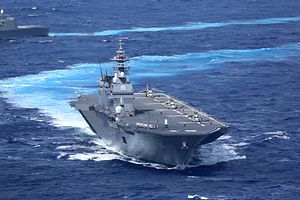The Japan Maritime Self-Defense Force’s (JMSDF) largest warship, the so-called helicopter destroyer JS Izumo, the lead ship of the Izumo-class, along with its sister ship, JS Kaga, have already been designed to operate short take-off and vertical landing (STOVL) fighters such as Lockheed Martin’s F-35B, retired JMSDF sources told Japan’s Asahi Shimbun newspaper last week.
While Japan’s Ministry of Defense (MoD) has repeatedly denied plans to retrofit the Izumo-class into full-fledged aircraft carriers–euphemistically classified as helicopter destroyers by the JMSDF to downplay the ships’ offensive warfighting capabilities– a JMSDF executive said that a consensus was privately reached at the inception of the Izumo project that the warships should be designed allowing for a future conversion into a F-35B-carrying naval platform.
“It is only reasonable to design (the Izumo) with the prospect of possible changes of the circumstances in the decades ahead,” the JMSDF executive said. “We viewed that whether the Izumo should be actually refitted could be decided by the government.” Indeed, it is unsurprising that consideration was given to operate the F-35B–the U.S. Marine Corps variant of F-35 Joint Strike Fighter capable of vertical or short takeoffs and vertical landings without requiring a catapult launcher—from the Izumo’s flight deck, as the ministry has repeatedly expressed interest in acquiring the aircraft over the years.
MoD sources have only recently reiterated the MoDs interest in procuring F-35Bs for service aboard the Izumo-class and from airfields on Japanese-held islands skirting the East China Sea. Modifications on the Izumo-class, among other things, would require the installation of a ski-jump. Contrary to earlier reports, the JMSDF executive claims that the flight deck has already been coated with paint that can withstand the exhaust heat generated during F-35B landings and takeoffs. Additionally, the aircraft elevators connecting the flight deck with the hangar was reportedly specifically designed to accommodate the F-35B.
The Izumo-class is the biggest class of surface warship to be operated by the JMSDF since the end of World War II. While it is a multi-purpose warship, the Izumo-class’ biggest comparative advantage to other vessels in the JMSDFs surface fleet is its sophisticated anti-submarine warfare (ASW) capability. For example, Izumo-class ships can operate a large number of Japan’s most advanced sub-hunting helicopter. “The ship is designed to accommodate up to 14 helicopters (seven Mitsubishi-built SH-60k ASW helicopters and seven Agusta Westland MCM-101 mine countermeasure helicopters), five of which can simultaneously take off and land, given the Izumo’s large flight deck and five landing spots,” I explained previously.
Should the Izumo-class undergo a retrofit to accommodate the F-35B, the ships’ ASW capabilities would be somewhat curtailed, as numerous defense analysts have pointed out. The Izumo-class conversion debate in Japan occurs in the context of an increasing vulnerability of Japanese airbases to Chinese and North Korean cruise and ballistic missile strikes. F-35Bs operating from Izumo-class carriers would at least theoretically increase the chances of Japanese airpower surviving a possible Chinese or North Korean first strike in the event of a military conflict.































